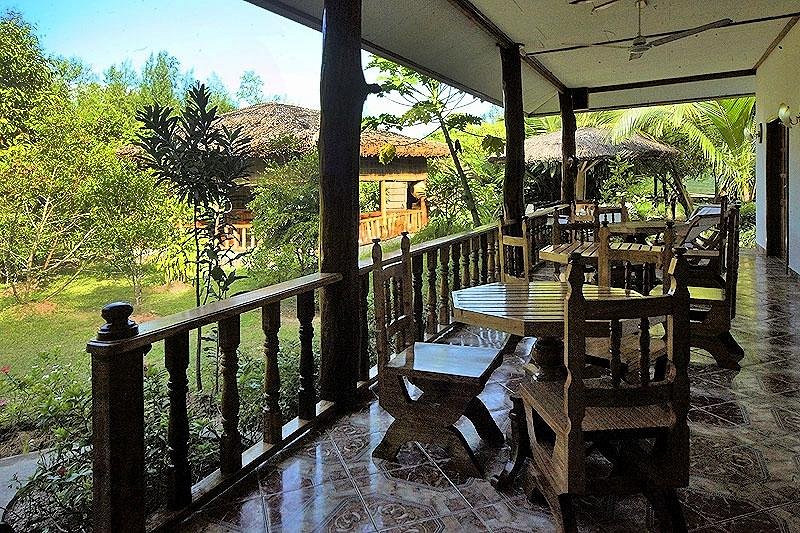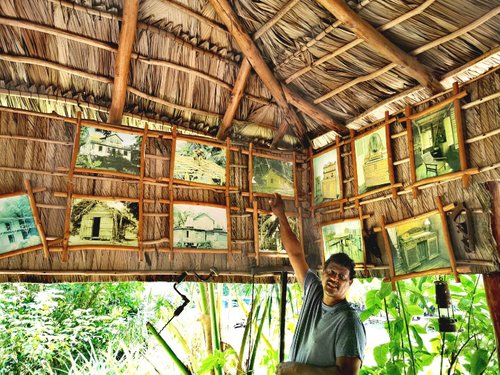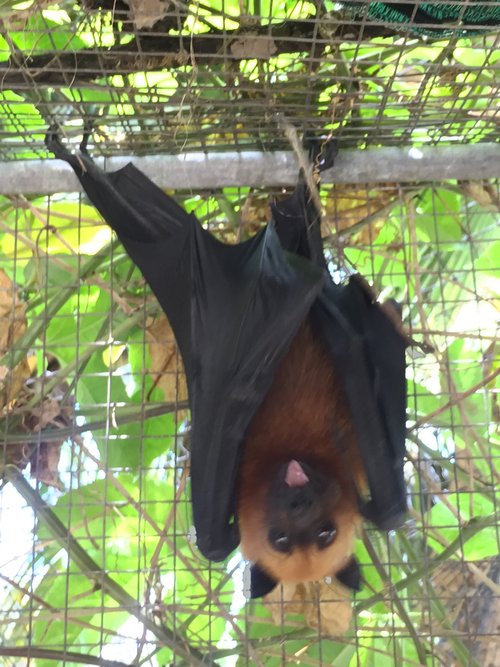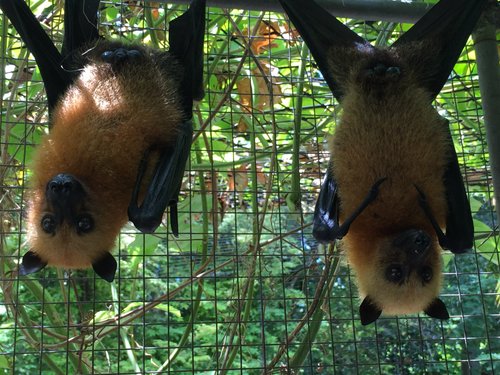Praslin Museum, Praslin Island, Seychelles
3.5 (91 reviews) Monday: 9:00 AM - 6:00 PM Spent Ranking #19 in Praslin Island Speciality Museums

Absolutely must see and experience the fruitbats, the oldest giant tortoise, the coconuts, vanilla, lemongrass and other plants.
We were positively surprized of the museum, since it wasn't any museum inside a house, but an outside area with animals (giant tortoises, fruitbats, bunnies) and plants. We were warmly welcomed and we got a tour around the yard with a lot of information about the fruits, herbs, bats and turtles, and also some history of Seychelles and habits. The owner ofthe place and his doughter were very kind and joyful persons. At the end of the visit we had a chance to buy some of their products as spices, coffee, jewerly, oils and so on.








Address
Route de Cote d'Or , Seychelles.
Mobile
Website
http://praslinmuseum.29sud.com/index.php
Working hours
Monday : 9:00 AM - 6:00 PM
Tuesday : 9:00 AM - 6:00 PM
Wednesday : 9:00 AM - 6:00 PM
Thursday : 9:00 AM - 6:00 PM
Friday : 9:00 AM - 6:00 PM
Saturday :
Sunday :
Current local date and time now
Monday, May 13, 2024, 7:32
User Ratings
3.5 based on (91 reviews)
Reviews
-
4The Sabbatical Guide 5:00 PM Oct 6, 2017
Not your traditional museum, but worth a visit
Your opinion on the Praslin Museum will depend largely on whether you are a glass half full or a glass half empty person. There is no doubt it’s a bit of a disappointment when you arrive. No actual museum, a cage of fruit bats, a couple of old buildings and some luscious looking fruit trees. This is compounded when an old man wanders out and tells you the price. Swap out the word ‘Praslin’ with ‘Overpriced and ‘Museum’ with ‘Farm’ and you’ll be getting a bit closer to the truth. But then Steve arrives on the scene. Steve is a classic islander; tall, strongly built, with a Polynesian skin tone that could place on any atoll from Hawaii to New Zealand. He talks loudly with a confident and busy manner mixing his attention between the tour and the group of men around the estate cleaning, fixing and tending to the plants. His voice is big - almost inappropriately so for the size of the group - but there is alot of passion there. He’s clearly built this place from the ground up and where we are seeing something unfinished and still with alot of potential he feels pride at the effort that’s got it where it is today. He and his wife Jeanie not only run the Museum but also the guest house and restaurant attached. You have to love their entrepreneurial spirit, even if it does feel like they’ve overstretched slightly. We joined Steve’s tour group, a German couple who were looking incredibly confused by proceedings. Parking up and becoming part of a tour happened almost instantaneously, strange enough when you are expecting a building with some dusty artefacts inside even more so when it happens in a language you don’t fully understand. We had missed the start by 5 minutes or so but Steve reassured us this was ok, he’d catch us up at the end. We started at the guinea pigs cage. They were guinea pigs. What more can I say. I can get a similar experience in my local pet shop. Steve did his best ‘water into wine’ act giving us a full history of guinea pigs, but they were still just guinea pigs. We were joined by a tiny little ginger kitten who was to become our companion for the rest of the tour. The classic African waif-like animal; skinny, dirty, desperate for attention and largely ignored. Despite this it seemed pretty happy, rolling around in the dust and letting off the occasional inharmonious high-pitched mew. We moved on with the tour. Steve picked up a coconut still in its husk and demonstrated how to correctly open one on a wooden spike in the ground. On our first day I’d found a coconut lying on the beach - it took me two days of smashing it into a rock just to get the husk off. Steve had his open in seconds ‘if a man on Seychelles cannot open a coconut he is not a man worthy of a Seychellian woman’ he said, as if peering into my inner thoughts. I reassured myself that the statement mentioned nothing about timescales the only goal was an open coconut. Manhood intact I brought my attention back to the tour. By now Steve had smashed the coconut itself on a rock, and in a show of skill had managed to not only split it perfectly in half but also not lose the milk inside - which he had handed to the German couple to drink. The old man appeared again and sat on what looked like a milking stool with a twist. Coming out of the front was the spike of a knife, attached so the place was parallel to the ground. He took half of the coconut from Steve and with the skill of a man who has passed his 10,000 hours of expert practice shredded the inside of the coconut into a bowl. Within seconds the nut itself was an empty shell and we were left with a bowl of the most beautifully fresh desiccated coconut you are ever likely to taste. It was handed around and much enjoyed by all. We moved into a little wooden shelter where all the different parts of the coconut were laid out. ‘We use it all’ he said ‘the nut we decorate for tourists, the meat we press into oil, the husk protects the crops even the leaves we use to sweep up’. He did a little demonstration with a leaf to prove his point. We left the shelter having also smelt some of the cinnamon they had farmed and moved onto a structure that was being repaired with palm leaves. ‘Traditional Seychelles kitchen. Kept separate from the house, anyone know why?’ ‘Just in case it burnt down’ I offered. ‘Yes sir you are right, if your kitchen burns it is nice that your house doesn’t!’. I mean honestly I’d rather neither but I see his point. When your house is built with palm leaves and contains fire the chances are pretty high. Onto the next building, the most museum like of anything we’d seen so far. The walls were covered with beautiful old pictures of the island; Victoria before all the construction, the building of the airport, palm forests. Steve talked us through each of the pictures putting a little story behind each one. The old man scuttled in again, this time with a tray of fresh juice. He met Steve’s eye to check it was ok and then offered one to each of us whilst desperately trying to avoid being tripped up by the little ginger cat. Steve moved on to some traditional tools and picked up one, a length of what looked like bamboo tubing with string attached which was held taught by length of cane. ‘Guess what this is’ Steve said, as much a direction as a question ‘in 10 years only 2 people have got it right’. No one did. It was not timidity more a general confusion. It was a device unlike anything I’d seen before. ‘Rat trap’ came the answer from Steve, looking pleased that another group had failed ‘they go in here after some nice coconut and then’ he made a strangling motion. In the far corner of room were more strange looking contraptions which could easily have been for larger prey. Devices made from bits of tree, string, palm and nut. These turned out to be instruments. Some for shaking, others for hitting and plucking. Steve handed them around and picked up the big one himself. It was like a one string double bass with a large coconut strapped halfway down keeping the twine away from the broom handle like piece of wood that formed the backbone. In a pitch that would not have sounded out of place in a market scene of ‘Only Fools and Horses’ he claimed he was one of only 2 people on the island to be able to play it. I was handed a wooden Guiro like hollow piece of wood and the anxious looking German lady a home made maraca. Steve on lead we had a jam which the like of which will never be repeated. If you want to recreate it for yourself imagine the sound a man in clogs holding a bowl of rice falling down a wooden staircase and you won’t be too far off. At this point the German couple left, this was the point of the tour they’d seen before. Steve whisked us around the gardens showing us traditional medicinal plants from lemongrass to vanilla and many in between. Unfortunately due to the rush on arrival I’d left my notebook in the car so details are vague but most seemed to be routed in ancient medicine and witchcraft but were now rapidly being taken on by the western world as more scientific study was done. After the gardens we moved on to the pen of giant tortoises. They were a happy looking bunch lazing around in the sunshine and eating up the fallen fruit from the tree above. The giant tortoises on the Seychelles are one of only two indigenous populations on earth - the other is on the Galapagos - but they are no longer found on Praslin island. If you want to see them roaming wild the best place locally is to head over to Curieuse. They do seem to be the pet of choice around Praslin though and can be found in unspacious holdings outside anything from houses to supermarkets. Steve ripped off some leaves and let us feed them. There were three, a big male and his two lady friends. ‘A great life’ Steve said, ‘two younger women’. He was the biggest we’d seen on the island, and it was claimed his age was 128! Next we moved over to the fruit bats who were clinging to the edge of their chicken wired enclosure. We’d seen them flying around the island like ancient creatures on a lost world. Unusually for bats they were regularly seen out flying around in the day and if you’re not expecting it they are a very odd site. You look up at the sky to see what you think is a bird but what you get is a very different silhouette; a plump body, wings held out in the classic fan like shape. It was good to get to see them up close. They are bigger than most bats with cute vulpine like faces and a covering of fine sandy fur making their nickname of ‘flying foxes’ understandable. They have big black disc eyes, again different to most bats as they find fruit by sight as well as smell. The were alert and well kept, hanging upside down and flapping around their holding. We were ushered inside. This is not like some British Zoo, just head in and have a look! They were beautiful to see up close, something you would be very unlikely to do in the wild. Steve said they looked so good as he let them out at night and they always choose to come back. I wasn’t convinced. So there it was, the Praslin Museum. What it lacked in execution it made up for in spirit. It felt more expensive than it should have done for the experience but I just hope the money goes to good use. It would be great to see this place continue to improve whilst maintaining its rustic charm. You can see from reviews online it polarises opinion. It sits at 3/5 on average with most people holding the view of one extreme or another. It seems you either get what they are trying to do here, or you don’t - glass half full or glass half empty. The accusations of this being a tourist money spinner I think are unfounded, though my natural tendency is to want to trust things are being done for the right reasons. It certainly does not conform to the tourist ideal; pictures and signs, glass cases and perfect pathways. This is more a teaching experience and if you are willing to listen you will learn. If you are looking for pretty pictures then you are in the wrong place but if you want to learn a bit more about traditional island life then open your ears and take it in.



-
4JoannaMic 5:00 PM Aug 20, 2013
Fruit Bats are the main attraction
I was really exited to go to visit the museum and I made a special day to go and do so. I arrive at 2:30 and has been told that the guided tour starts at 3:00 . I decided to wait and sit on the one of the comfortable seats. I have been given a glass of orange juice, passion fruit and a few bananas while I wait. This was very nice gesture. The young lady inform me that the tour starts at 3:00 and ticket cost 180 rupees ( almost £10) and include a glass of juice. At about 2:50 a man arrive in the car which is happened to be the guide. I was the only person on the quid end tour, and the gentlemen took around with the speed of light. By 3:00 I was done. First we went to see the fruit bats which was the highlight of the place. The men give them a little banana and when I ask if I can feed then, he told me its to late now and we should move on. Next we see the giant turtles which are everywhere to be seen on the island and then with a speed of light we went thru all medical plants which I have been given a lil story about each one. The were also a few pic hanging around to see, but they were really old and bad quality. While asked about chameleons and black parrots which were highlighted to see there, the tour guide stated that a few month back they were removed from the side. So the main attraction was the bats really, not really worth it the price.
See also
More Things to do in Praslin Island
- Points of Interest & Landmarks in Praslin Island
- Art Museums in Praslin Island
- Speciality Museums in Praslin Island
- Religious Sites in Praslin Island
- Nature & Wildlife Areas in Praslin Island
- Spas in Praslin Island
- Speciality & Gift Shops in Praslin Island
- Day Trips in Praslin Island
- Taxis & Shuttles in Praslin Island
- Scuba & Snorkelling in Praslin Island
- Boat Tours in Praslin Island
- Lookouts in Praslin Island
- Bodies of Water in Praslin Island
- Beaches in Praslin Island
- Ferries in Praslin Island
- Hiking Trails in Praslin Island
- Farms in Praslin Island
- Shopping Malls in Praslin Island
- Islands in Praslin Island
- Bus Services in Praslin Island
- Art Galleries in Praslin Island